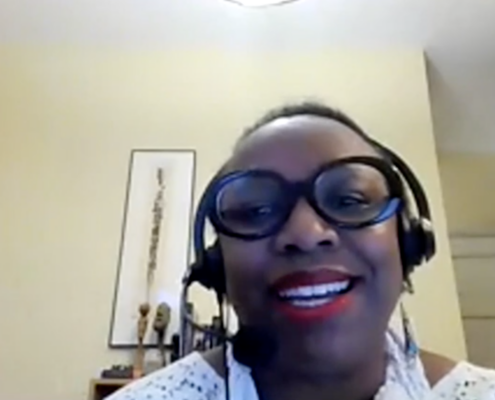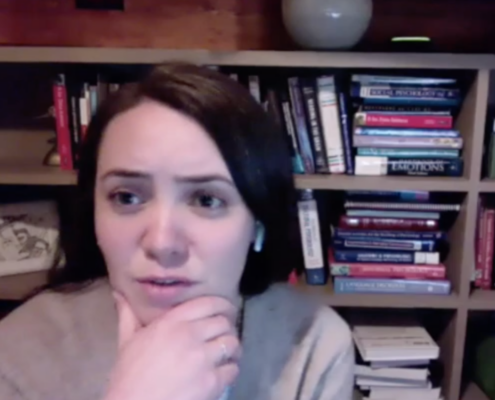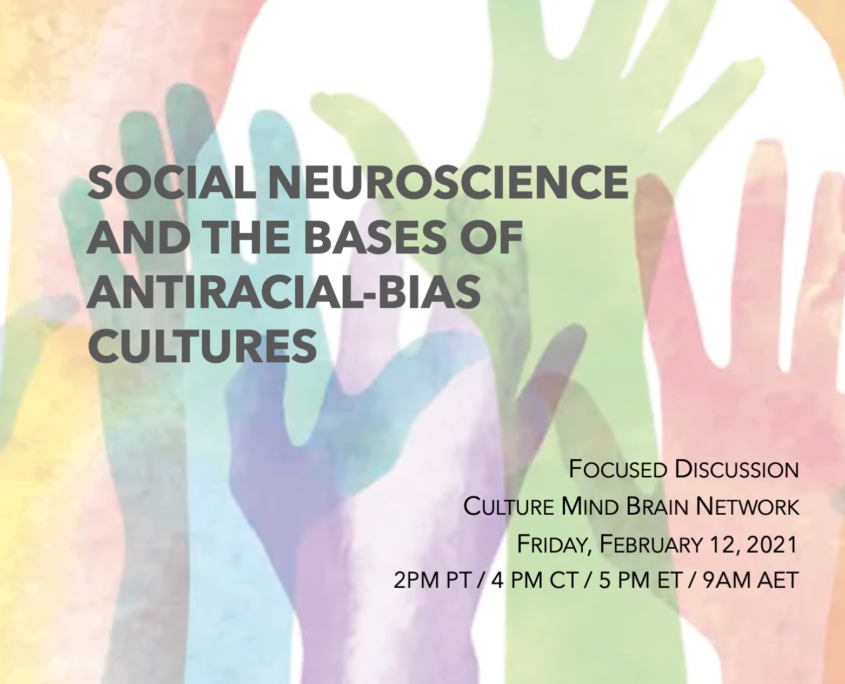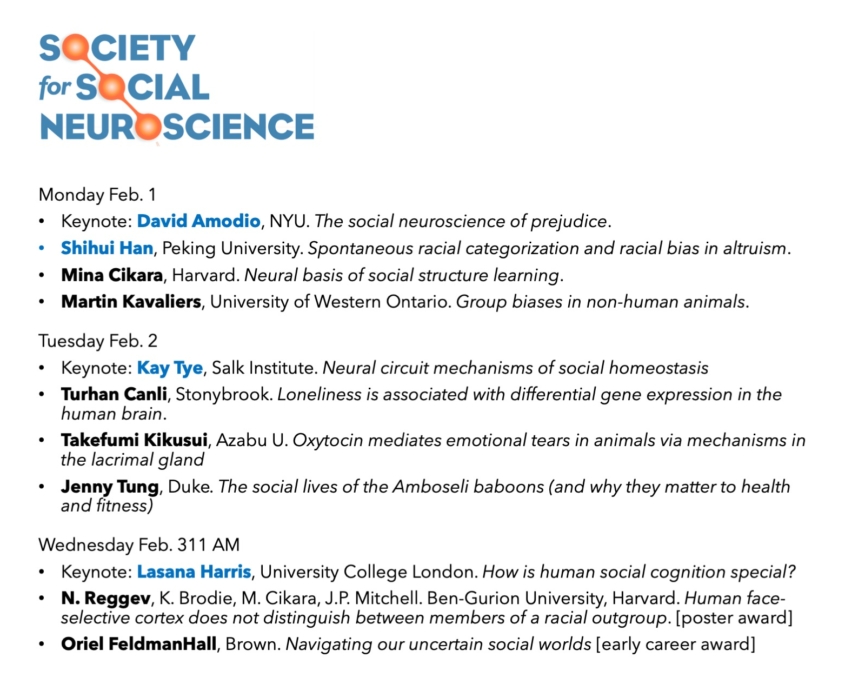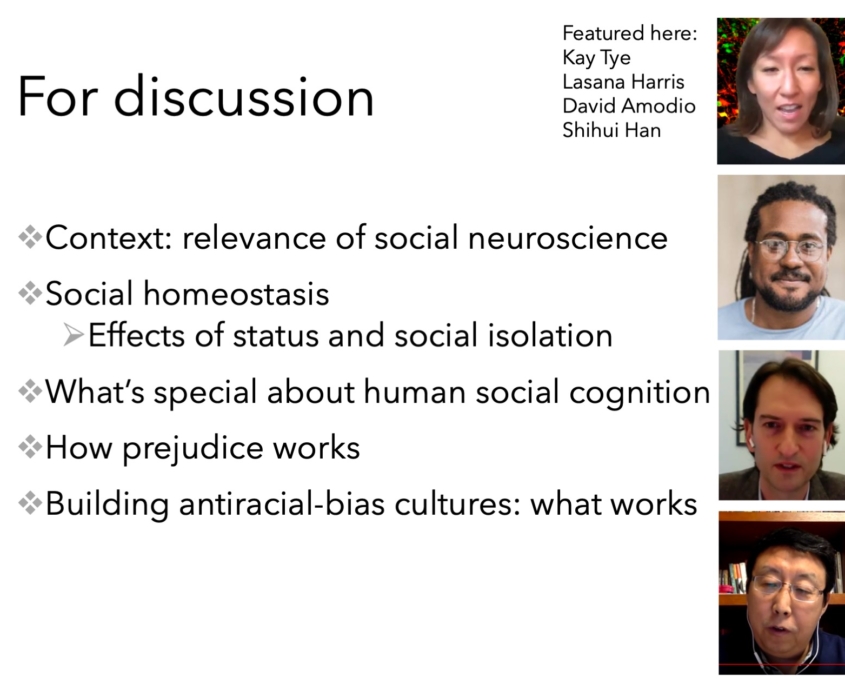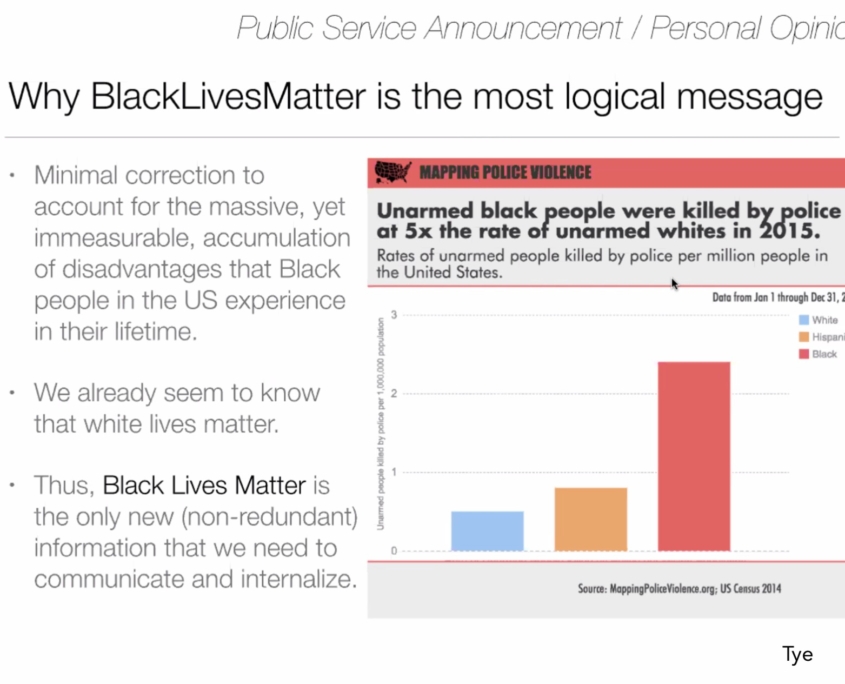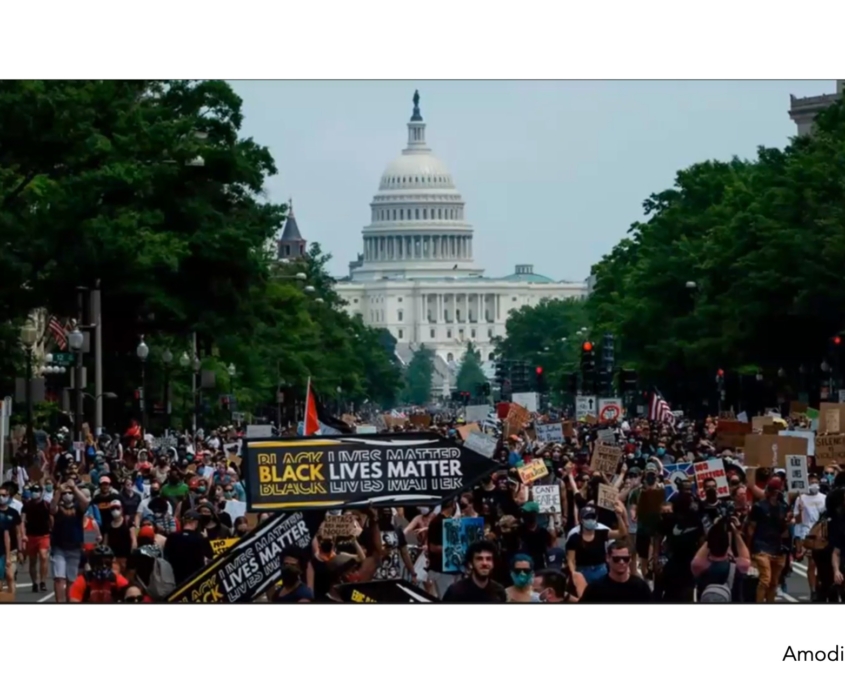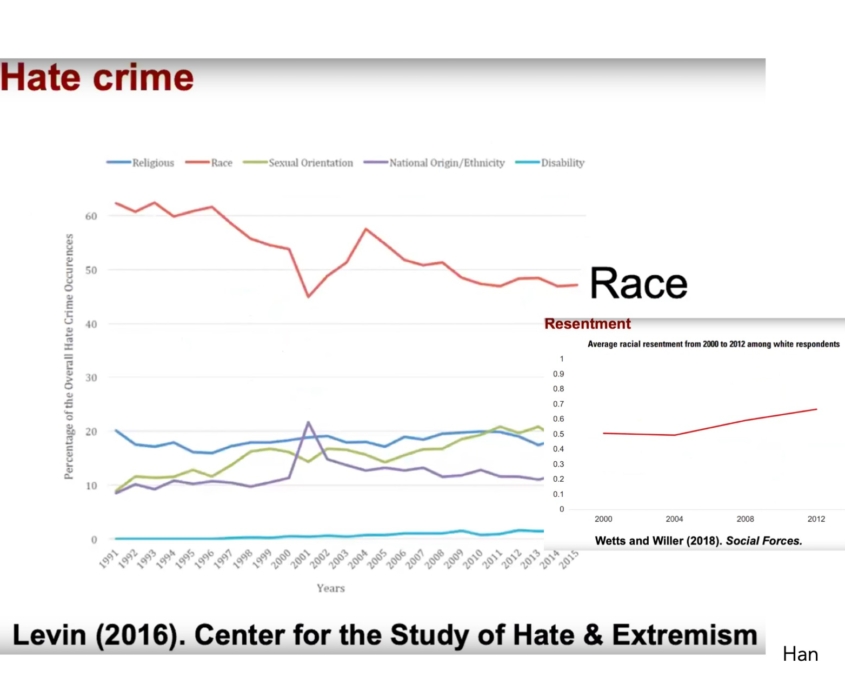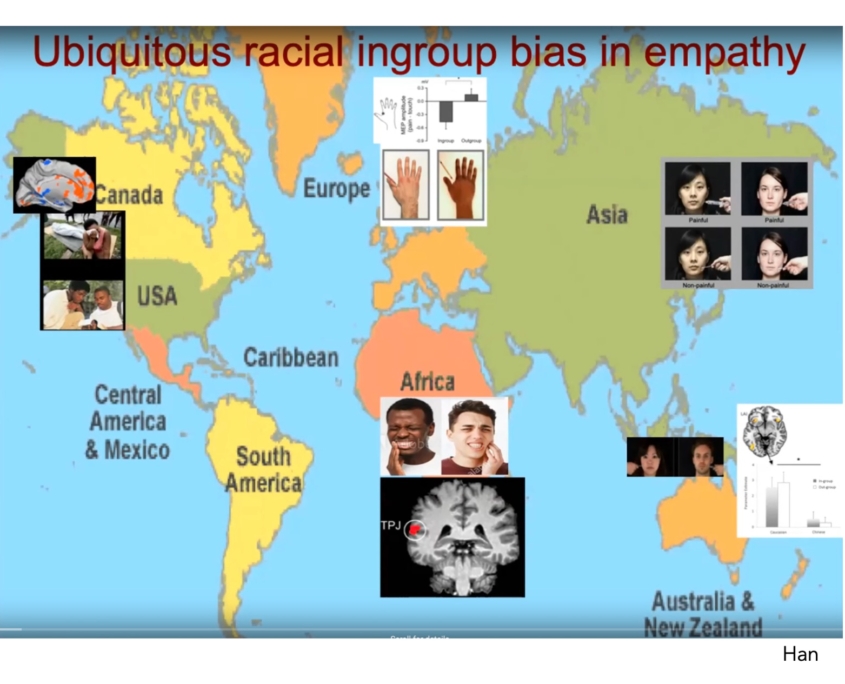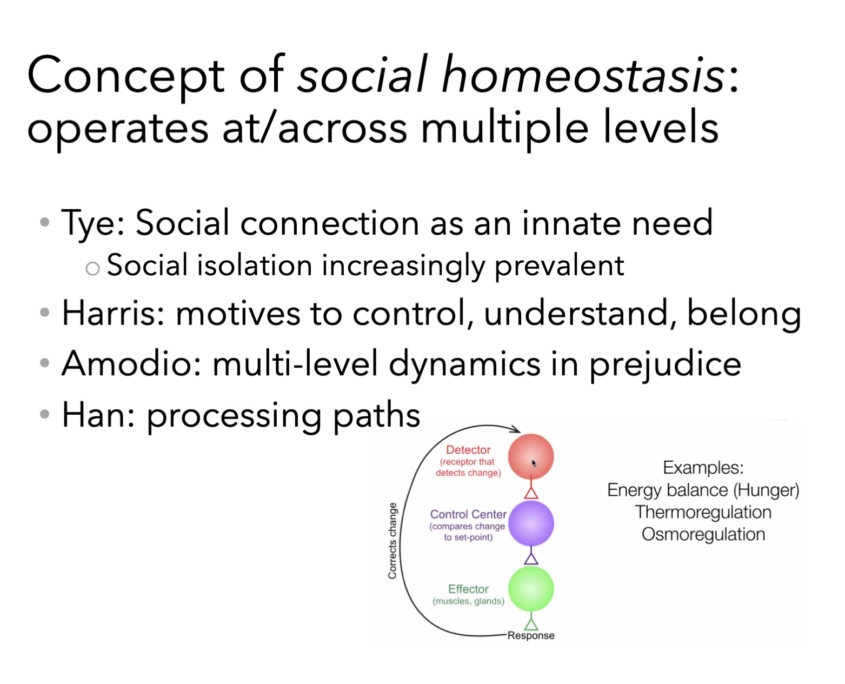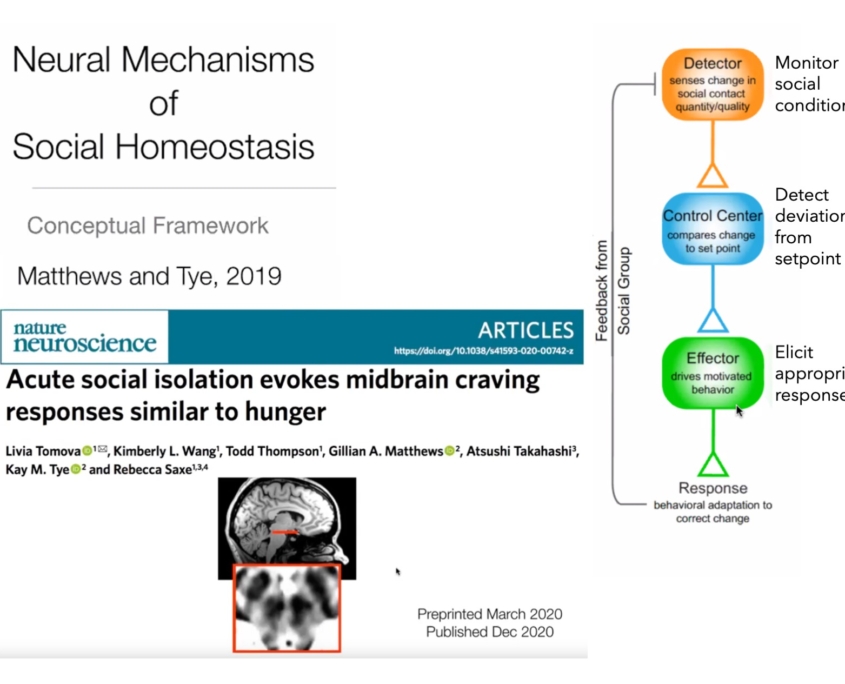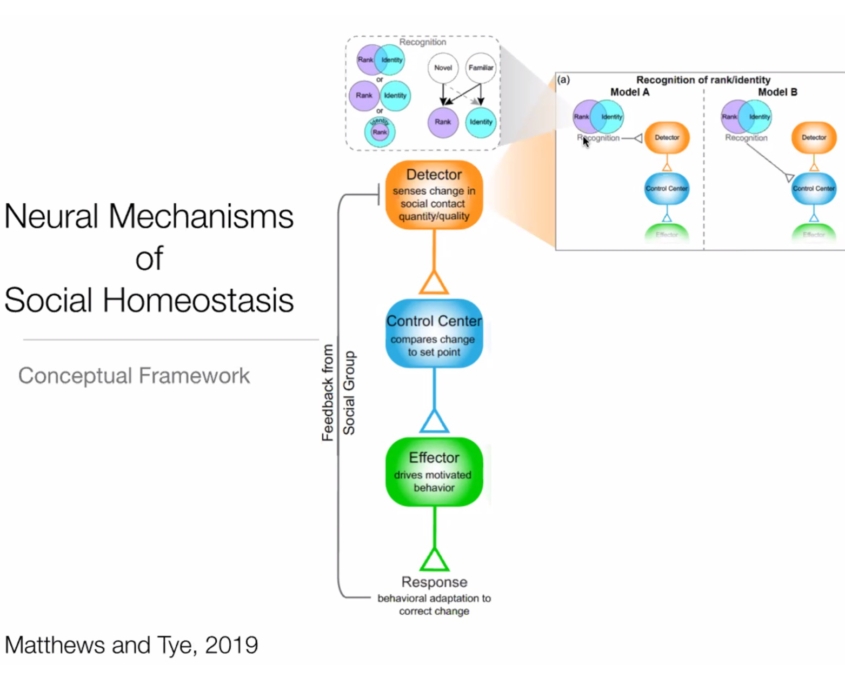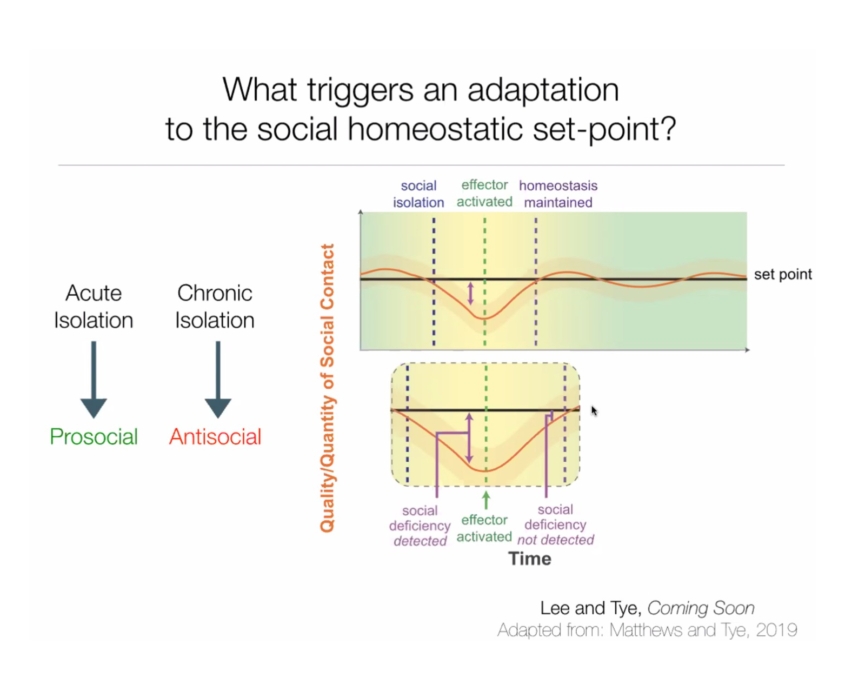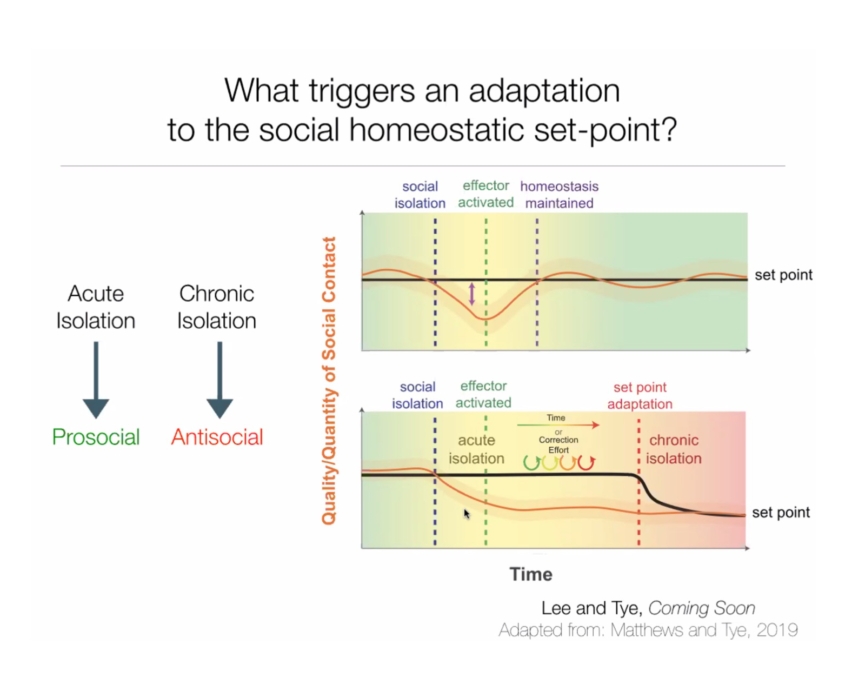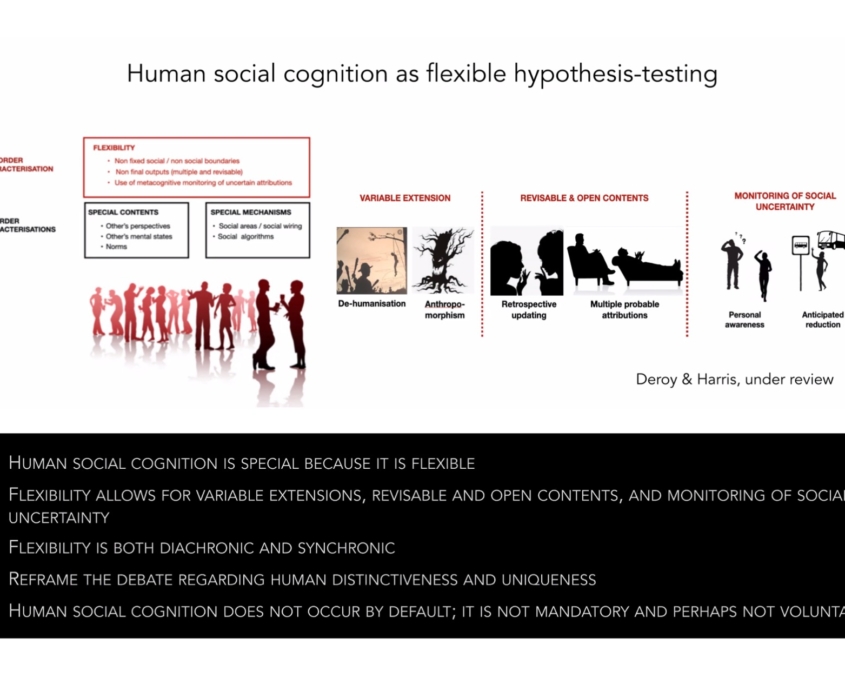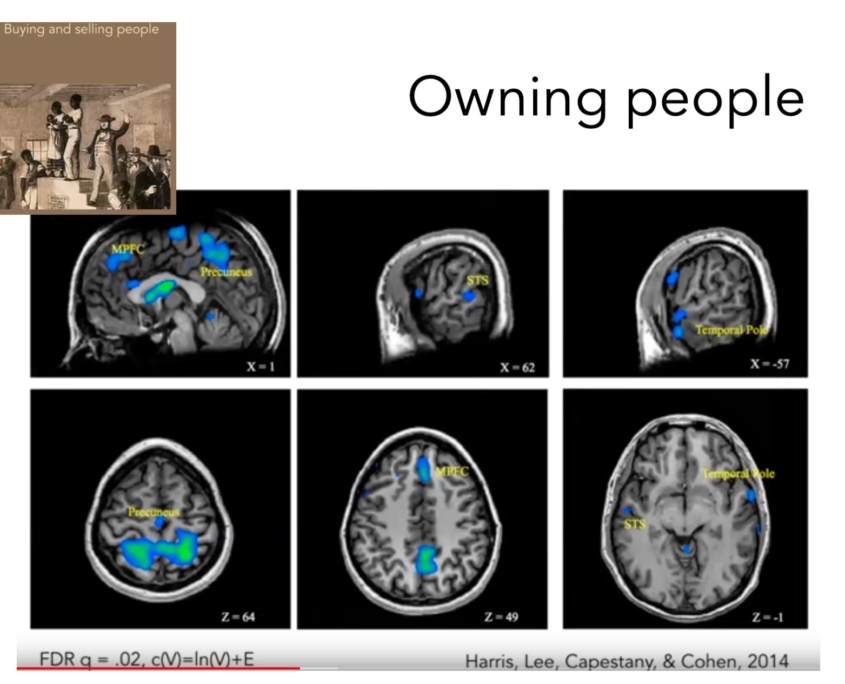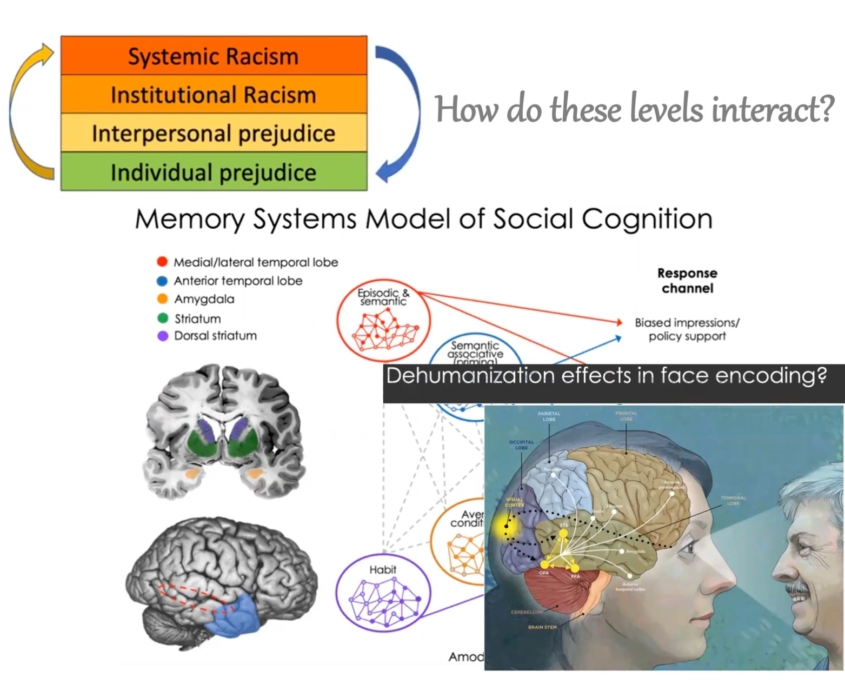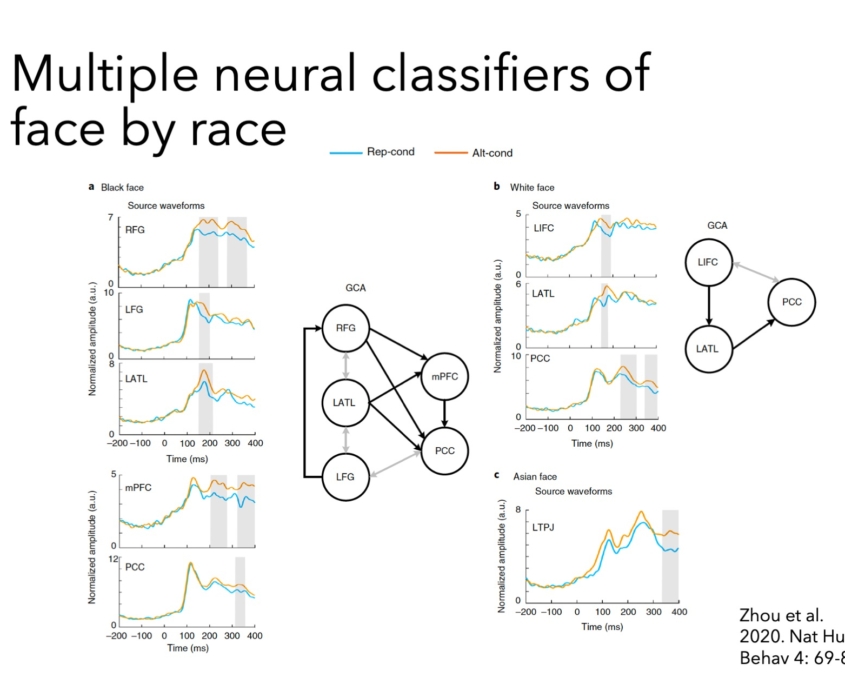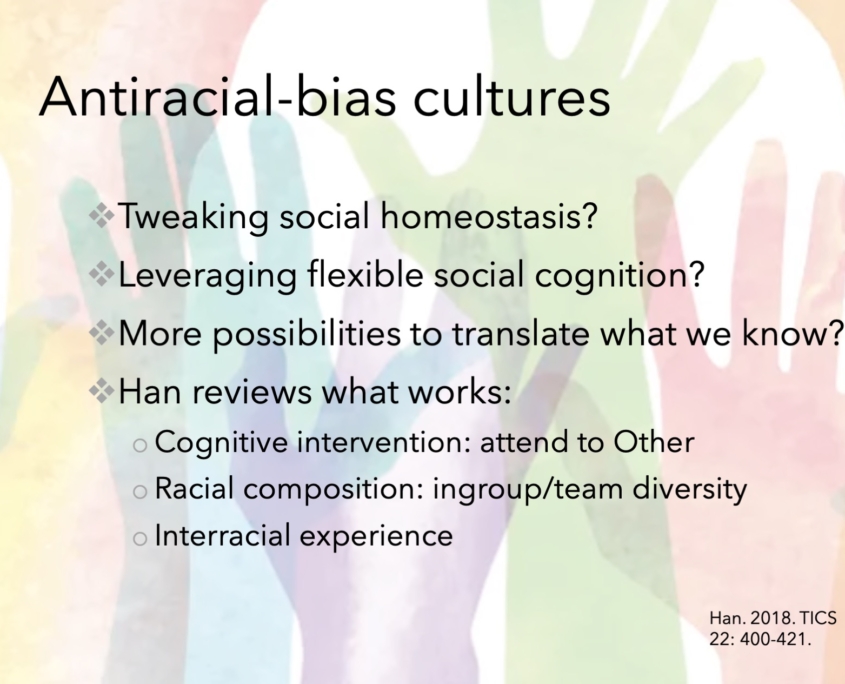Videos (30 mins each)
Summary
CMB Network Member Participants: Carol Worthman; Greg Downey, Maria Gendron, Shinobu Kitayama, Daniel Lende, Tanya Luhrmann, Sally Seraphin, Tawni Tidwell, Kathy Trang
The group discussed some key findings from the social neuroscience conference that shed light on neural underpinnings, or antecedents, of interpersonal biases and prejudice, primarily focusing on Shihui Han, Lasana Harris, Oriel FeldmanHall, and Kay Tye on (1) face perception/categorization; (2) dehumanization; (3) politically based neural synchrony; and (4) social homeostasis. Below is a brief recap of the talks mentioned followed by a summary of the CMB network discussion.
The group discussed the following social neuroscience findings from S4SN:
- Same- vs. other-race bias occurs across multiple brain regions and timescales. Using a variety of methods (EEG, fMRI, MEG), Han’s group found evidence for spontaneous, early detection of other-race faces vs. same-race faces (e.g., ERP: P2, vs. N2), with implications for cognition, emotion, and decision-making (Shihui Han).
- The human social cognition brain network is special because it’s diachronically and synchronically flexible as well as exquisitely sensitive to social context, the point being it’s not a spontaneous response, we can engage it or withhold it at any time, i.e., anthropomorphize or dehumanize (as well as retroactively update our impressions, activate stereotypes or infer traits in others, and monitor social uncertainty). Dehumanization involves brain deactivation in areas such as the medial prefrontal cortex (part of the social cognition network, overlaps with default mode network) (Lasana Harris, Keynote).
- Ideological similarities are associated with increased neural synchrony between political partisans, which is modulated by intolerance to the uncertainty of social interactions, i.e., uncertainty bias may be driving polarized perceptions. Hyperscanning (recording the brains of two or more individuals using, e.g., fMRI) suggests that it’s not just differences in ideology: individuals averse to uncertainty exposed to debate videos experienced greater brain-to-brain synchrony in the TPJ, anterior insula, and precuneus with politically like-minded peers, regardless of whether they were liberal or conservative, and lower synchrony with political opponents. Another line of research (“stimulus generalization”) focuses on our propensity to distrust strangers who are perceptually similar to someone we consider untrustworthy (Oriel FeldmanHall).
- The brain actively seeks to maintain a set-point for social contact (“social homeostasis”) and to avoid social isolation and loneliness. Optogenetic studies in mice indicate dopamine neurons in the dorsal raphe nucleus of the brainstem are particularly sensitive to acute social isolation; further, these effects are modulated by dominant/subordinate social rank (with the medial prefrontal cortex (PFC ,and more specifically PFC-lateral hypothalamous neurons) playing a key role in both encoding rank and flexibly adjusting behavior. In mice, Tye et al. were able to decode relative rank and even wins/losses before they happen from PFC neural activity alone. Finally, Tye differentiated acute vs. chronic isolation, with former promoting prosociality but latter antisocial behavior (i.e., an adaptation?) on reintroduction to social group (Kay Tye, Keynote).
Below are some highlights of the group’s discussion (loosely organized under headings). The discussion opened with a question posed by Kathy Trang: Can neuroscience provide points of entry for interventions, policies, and practices addressing racism and other inequities?
Relevance of neuroscience
- Tanya was skeptical that neuroscience can meaningfully intervene in people’s lives and at the level of policy. Sally agreed but mentioned Reggev’s work on the importance of early life exposure to diversity. (A recent paper indicated that that racial ingroup but not outgroup faces activate the FFA, suggesting an outgroup homogeneity effect occurs early in visual processing; Reggev et al., 2020). Greg also struggled to see the relevance of neuroscience; are exposure interventions sufficient? Taking up an earlier point Maria made, he said interpersonal bias is easy to measure and gives the mistaken impression of representing the whole problem, but a lot of the social context behind dehumanization cannot be captured in the lab.
- Shinobu said when he started to integrate neuroscience, people asked: Why spend so much money to prove William James and Aristotle were right? But neuroscience and behavioral social psychology research are able to demonstrate that prejudice is a multifaceted, complex phenomenon, e.g., implicit bias versus explicit bias. But he also said it is hard to draw clear implications for social policies and to disentangle complex mechanisms in the brain for phenomena such as stereotyping and prejudice, some aspects of which may be addressed, but not all. He also noted that practical application– in law courts or in marketing – is not the main point of the field. In such real-world settings, the quality of the science can be compromised if the person applying the method lacks training or scientific integrity.
- Greg said we need to design more intermediate-level processing research that addresses these kinds of issues. Shinobu agreed, noting that there are a lot of social psychological intervention studies (e.g., on empathy, perspective-taking, or belonging) that can help to eliminate disparity in achievement. High tech wearables, including brain-scanning backpacks; various forms of multi-person hyperscanning; and other more ecologically valid methods are also now in use, with more on the horizon, although Shionobu cautioned that focusing on practicality could easily compromise research quality. Ultimately, he said, it is hard to do both research and application at the same time.
Dehumanization and diversity
- Referring back to the Harris talk on dehumanization, Daniel thought a neuroscientific account is not enough to understand how dehumanization happens in context and over time (cf. Worthman’s work on a child’s first 1000 days of life and experiments showing infants human faces). Tawni mentioned the work of social psychologist Nilanjana “Buju” Dasgupta on how life experience inoculates students against negative stereotypes (via significant experiencing of persons of color, e.g., having professors, mentors, and students of color as an intervention), but effects of early intervention may not show up in the brain for years.
- Following up on Harris and the idea of the nonspontaneous effort required to activate the mPFC for humanization, Maria mentioned social psychologist Kurt Hugenberg’s work on this in the area of emotion perception and cultural differences. There is an accuracy problem in how we perceive others’ emotions by reading their faces (related to variation in how people move their faces) and possibly a motivation problem (less affiliative goals or desire to accurately read faces of outgroup members). Perception of psychological diversity or diversity of minds requires perceived effort to bridge that. She said there is complexity when people are motivated to perceive mind and how it intersects with experience, which is needed to combat misperceptions. Responding to Maria, Sally mentioned neuroscientist FeldmanHall’s research on asymmetry in learning and fear-based learning: one negative experience with an outgroup was sufficient to shape future interactions.
- Can the amount of effort required for activation of the social cognitive network and humanization be a marker to track progress or effects of an intervention?
The flexible brain: Ingroups and outgroups
- Carol brought the discussion back to Han, who described different pathways for reacting to same or other-race faces. The Black faces required more effort to process. Where does that come from? Greg suggested it’s a function of training. Sally wondered what the evolutionary advantage might be of processing faces you might not meet. Shinobu thought the basis of ingroup/outgroup distinction wasn’t necessarily race but who’s on your team (Jay Van Bavel ), cf., the minimal group paradigm.
- Carol asked, where do these minimal groups come from and who drives the ingroup/outgroup discourse? What drives the perception of which group you belong to? Sally referred to FeldmanHall’s research (based on fMRI combined with methods for inter-subject analysis ) suggesting that polarizing language leads to neural synchrony within groups (neural synchrony was modulated by uncertainty aversion). Maria said there is a reason why we form these coalitions, even those based on superficial things. She also mentioned group identification and how scarcity of resources can lead to harmful group dynamics.
- Both Carol and Daniel mentioned Tye’s talk, the link between social isolation and social affiliation. Carol liked Tye’s idea of social homeostasis, dynamic systems trying to minimize the work, but some systems are primed to be challenging. What are the easiest states for people to stay in? What pushes them into those states? What are the affordances that could move them out of those states?
- Daniel said that social isolation or social defeat can lead to the search for an ingroup or hierarchical structure. According to Tye, the midbrain craving for social interactions is similar to hunger. Sally mentioned the opioid crisis (from economic devastation and marginalization) or the trigger for WWII (Germans’ rights being taken away). Such conditions (social isolation, scarcity of resources, despair, dehumanization) can increase the hunger for social analgesia to relieve pain. (Sally and Shinobu are focusing on the analgesia effect during the COVID pandemic in their new CMB grant.)
Using a variety of behavioral and multiple neuroscience methods (EEG, MEG, fMRI, brain-to-brain synchrony, inter-subject analysis, optogenetics in rodents, etc.), research is homing in on some of the neural mechanisms underlying our political allegiances, desires, and biases, providing support for some common-sense interventions, and certainly sharpening our understanding of how brain processes are orchestrated compared to ten or twenty years ago.
Toward the end of the discussion, Sally asked, where does synchronization begin? It is not when you lose a job, for example. It happens in pre-verbal early life as preparation for where you will live. It is fitting that our next discussion on March 12, will feature psychiatric neuroscientist Brian Dias on epigenetics and the transgenerational transmission of trauma.
S4SN Reading
The Neurobiology of Intergroup Biases
- Amodio, D., & Cikara M. (2021). The social neuroscience of prejudice. Annual Review of Psychology.
- Han, S. (2018). Neurocognitive basis of racial ingroup bias in empathy. Trends in Cognitive Sciences, 22(5), 400–421. https://doi.org/10.1016/j.tics.2018.02.013
- Reggev, N., Brodie, K., Cikara, M., & Mitchell, J. P. (2020). Human face-selective cortex does not distinguish between members of a racial group. eNeuro, 7(3), ENEURO.0431-19.2020. https://doi.org/10.1523/ENEURO.0431-19.2020
- Zhou, Y., Gao, T., Zhang, T., Li, W., Wu, T., Han, X., & Han, S. (2020). Neural dynamics of racial categorization predicts racial bias in face recognition and altruism. Nature Human Behavior, 4, 69–87.
Social Isolation and Social Connection
- Matthews, G. A., & Tye, K. M. (2019). Neural mechanisms of social homeostasis. Annals of the New York Academy of Sciences, 1457(1), 5–25.
- Padilla-Coreano, N., et al. (2021). A cortical-hypothalamic circuit decodes social rank and promotes dominance behavior [Preprint]. https://doi.org/10.21203/rs.3.rs-94115/v1
- van Baar, Halpern, D. J., & FeldmanHall, O. (2021). Intolerance of uncertainty modulates neural synchrony during politically polarized perception. Preprint.
Dehumanization / Anthropomorphism
- Harris, L. T., & Fiske, S. T. (2006). Dehumanizing the lowest of the low: Neuroimaging responses to extreme out-groups. Psychological Science, 17(10), 847–853. https://doi.org/10.1111/j.1467-9280.2006.01793.x
- Harris, L. T., van Etten, N., & Gimenez-Ferandez, T. (2020). Exploring how harming and helping behaviors drive prediction and explanation during anthropomorphism. Social Neuroscience.


